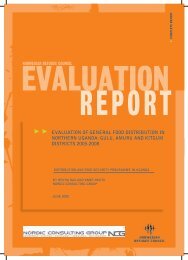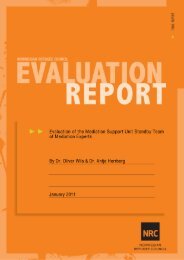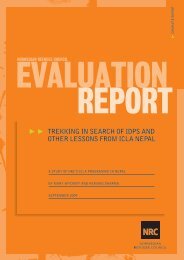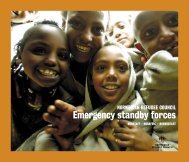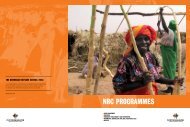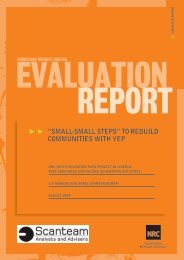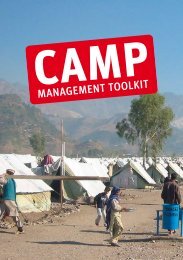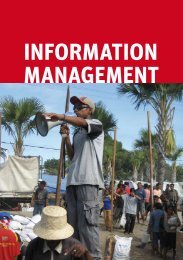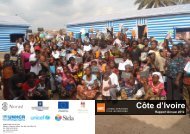Download report here - Norwegian Refugee Council
Download report here - Norwegian Refugee Council
Download report here - Norwegian Refugee Council
You also want an ePaper? Increase the reach of your titles
YUMPU automatically turns print PDFs into web optimized ePapers that Google loves.
Evaluation of NRC Food Security and Livelihoods Projects in Chiredzi and Chipinge Districts of Zimbabwe4. Impacts4.1 Impacts On Household Nutrition and Food SecurityStrong positive impacts were identified on the quantity and variety of food consumed within households,which increased overall in 83.5% and 77% of households respectively. The strongest improvementswere found within the Low Input Garden program w<strong>here</strong> 100% of households interviewed <strong>report</strong>ed thatboth quantity and variety of food consumed had increased, and the Conditional Cash Transfer w<strong>here</strong>over 99% increased both the quantity and variety of foods consumed. In contrast, in the small livestockprogram (particularly the goat component) the benefits of the program on income and nutrition are yet tobe realized, and expenses such as livestock medications have in a few cases actually decreasedincome and thus nutrition. The only other incidence recorded of a decline was one individual in theMarket Linkages program who had shifted their resources into the farming of the sorghum seedsdistributed, which then failed to yield the expected output due to adverse weather conditions (drought).Excluding the Small Livestock component from the total figures indicates that across all other programelements the quantity of food consumed has increased in 98.2% of households, and variety of foodconsumed has increased in 90% of households. Thus it is likely that once the benefits of the smalllivestock program start to accrue the combined average will rise significantly.Table 4.1 How has the quantity of foods consumed in the household changed during the project?Food Security and Livelihood ProgramIncreased(%)Same(%)Decreased(%)Number(N)Conservation Agriculture 99.3 0.7 0.0 143Low Input Gardens 100.0 0.0 0.0 132Small Livestock 26.7 72.6 0.7 146Market Linkages 92.8 6.2 1.0 97Income Generating Activities /CCT 1 98.4 1.6 0.0 62Unconditional Cash Transfer 99.2 0.8 0.0 129Total (All Programs) 83.5 16.2 0.3 709Total Excluding Small Livestock 98.2 1.6 0.2 5631. CCT = Conditional Cash TransferTable 4.2 How has the variety of foods consumed in the household changed during the project?Food Security and Livelihood ProgramIncreased(%)Same(%)Decreased(%)Number(N)Conservation Agriculture 69.9 30.1 0.0 143Low Input Gardens 100 0.0 0.0 139Small Livestock 26.0 74.0 0.0 146Market Linkages 92.8 7.2 0.0 97Income Generating Activities /CCT 90.3 9.7 0.0 62Unconditional Cash Transfer 99.2 0.8 0.0 129Total (All Programs) 77.0 23.0 0.0 716Total Excluding Small Livestock 90.0 10.0 0.0 570For all programs except unconditional cash, specific questions were asked to identify changes inconsumption of project-related produce had increased (Table 4.3). Again, t<strong>here</strong> was a marked increasein consumption of these products, the exception being small livestock w<strong>here</strong> only 22% of households<strong>report</strong>ed an increase in consumption of livestock products.3




